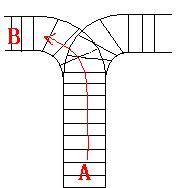杭电1002http://acm.hdu.edu.cn/showproblem.php?pid=1022
Train Problem I
Time Limit: 2000/1000 MS (Java/Others) Memory Limit: 65536/32768 K (Java/Others)
Total Submission(s): 25276 Accepted Submission(s): 9529
Problem Description
As the new term comes, the Ignatius Train Station is very busy nowadays. A lot of student want to get back to school by train(because the trains in the Ignatius Train Station is the fastest all over the world ^v^). But here comes a problem, there is only one railway where all the trains stop. So all the trains come in from one side and get out from the other side. For this problem, if train A gets into the railway first, and then train B gets into the railway before train A leaves, train A can't leave until train B leaves. The pictures below figure out the problem. Now the problem for you is, there are at most 9 trains in the station, all the trains has an ID(numbered from 1 to n), the trains get into the railway in an order O1, your task is to determine whether the trains can get out in an order O2.






Input
The input contains several test cases. Each test case consists of an integer, the number of trains, and two strings, the order of the trains come in:O1, and the order of the trains leave:O2. The input is terminated by the end of file. More details in the Sample Input.
Output
The output contains a string "No." if you can't exchange O2 to O1, or you should output a line contains "Yes.", and then output your way in exchanging the order(you should output "in" for a train getting into the railway, and "out" for a train getting out of the railway). Print a line contains "FINISH" after each test case. More details in the Sample Output.
Sample Input
3 123 321
3 123 312
Sample Output
Yes.
in
in
in
out
out
out
FINISH
No.
FINISH
For the first Sample Input, we let train 1 get in, then train 2 and train 3.
So now train 3 is at the top of the railway, so train 3 can leave first, then train 2 and train 1.
In the second Sample input, we should let train 3 leave first, so we have to let train 1 get in, then train 2 and train 3.
Now we can let train 3 leave.
But after that we can't let train 1 leave before train 2, because train 2 is at the top of the railway at the moment.
So we output "No.".
Hint
HintAuthor
Ignatius.L
Recommend
这个题要是手写栈的话一定要注意范围各个参数的范围
题意: 火车进站,出站能否按所给顺序出站 标准栈。
代码1:
1 #include<cstdio> 2 #include<string> 3 #include<iostream> 4 #define N 20 5 using namespace std; 6 string sc[N]; 7 string in,out; 8 char str[N]; 9 int main() 10 { 11 int t ,i , j ,c , k ; 12 while(~scanf("%d",&t)) 13 { 14 in.clear();out.clear(); 15 cin>>in>>out; 16 j = 0;c =0 ; k =0; 17 for( i = 0 ; i < t ; i++ ) 18 { 19 str[c]=in[i]; 20 sc[k++]="in"; 21 while(c!=-1&&str[c]==out[j])//这儿有点问题,c=0这儿有歧义,有时候栈为空,有时候不空,最好别这么写 22 //也就是,str有变化的时候,第一时间修改c的值 23 //这儿就是用混了,写成了c != 0,事实上,这儿c=0的时候,栈里还有一个元素 24 { 25 sc[k++] = "out"; 26 c--;j++; 27 } 28 c++; 29 } 30 if(j==t) {printf("Yes.\n"); 31 for( i = 0 ;i < k ; i++) 32 printf("%s\n", sc[i].c_str());} //string是不可以printf的,要用c_str函数,转为字符数组 33 else printf("No.\n"); 34 printf("FINISH\n");//少了换行 35 } 36 //system("PAUSE"); 37 return 0; 38 }
代码2:
1 #include<stdio.h> 2 #include<string.h> 3 #include<stack> 4 using namespace std; 5 int main() 6 { 7 int n, i, j, k, flag[50]; 8 char s1[15], s2[15]; 9 stack <char> s; 10 while(~scanf("%d %s%s",&n,s1,s2)) 11 { 12 while(!s.empty()) s.pop(); //也可以不写这一句,把 stack <char> s; 就可以了 13 memset(flag,-1,sizeof(flag)); 14 j = k = 0; 15 for(i = 0; i < n; i++) 16 { 17 s.push(s1[i]); 18 flag[k++] = 1; 19 while(!s.empty() && s.top() == s2[j]) 20 { 21 flag[k++] = 0; 22 s.pop(); 23 j++; 24 } 25 } 26 if(j == n) 27 { 28 printf("Yes.\n"); 29 for(i = 0; i < k; i++) 30 { 31 if(flag[i]) 32 printf("in\n"); 33 else 34 printf("out\n"); 35 } 36 } 37 else 38 printf("No.\n"); 39 printf("FINISH\n"); 40 } 41 return 0; 42 }
代码3:(感谢提供代码的伟大帅气的松哥~)
1 #include <cstdio> 2 using namespace std; 3 4 int main() 5 { 6 int n; 7 char o1[20], o2[20]; 8 int stack[20]; 9 bool ans[20]; 10 while(~scanf("%d", &n)) 11 { 12 scanf("%s %s", o1, o2); 13 int top = 0, cur = 0, c = 0; 14 for(int i = 0; i < n; i++) 15 { 16 stack[top++] = o1[i]-'0'; 17 ans[c++] = 1; 18 while(top > 0 && stack[top-1] == o2[cur]-'0') 19 { 20 top--; 21 cur++; 22 ans[c++] = 0; 23 } 24 } 25 if(top > 0) puts("No."); 26 else 27 { 28 puts("Yes."); 29 for(int i = 0; i < c; i++) 30 { 31 if(ans[i] == 0) puts("out"); 32 else puts("in"); 33 } 34 } 35 puts("FINISH"); 36 } 37 return 0; 38 }